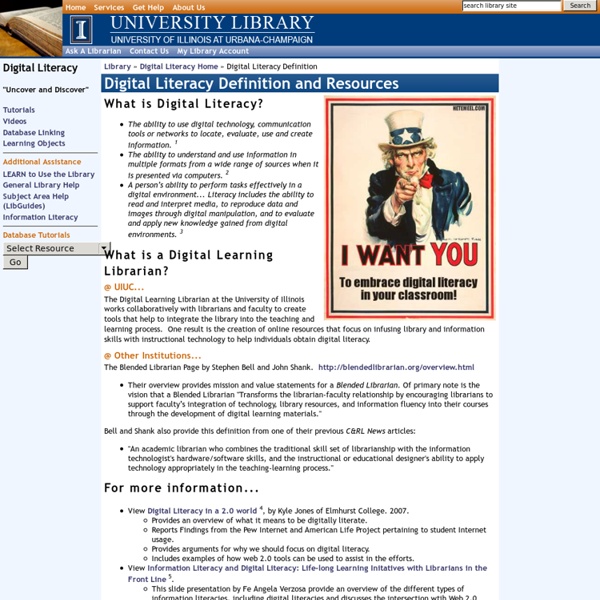Digital Literacy Definition and Resources

Digital Literacy Fundamentals
Introduction Today’s youth are often called ‘digital natives’ by adults because of the seemingly effortless way they engage with all things digital. It’s easy to see why: Canadian youth live in an interactive, “on demand” digital culture where they are used to accessing media whenever and wherever they want. But this enthusiasm masks a potential problem: although young people don’t need coaxing to take up Internet technologies and their skills quickly improve relative to their elders, without guidance they remain amateur users of information and communications technology (ICT), which raises concerns about a generation of youth who are not fully digitally literate, yet are deeply immersed in cyberspace. In order to be literate in today’s media-rich environments, young people need to develop knowledge, values and a whole range of critical thinking, communication and information management skills for the digital age. A basic question, then, is what exactly is digital literacy?
7 Reasons Why Digital Literacy is Important for Teachers - Blog | USC Rossier Online
What Is Digital Literacy?
Ava reads at Indian Run Elementary School in Dublin, Ohio. The school integrates iPads, laptops, and books into reading time. —Maddie McGarvey for Education Week Digital Literacy: An Evolving Definition While the word "literacy" alone generally refers to reading and writing skills, when you tack on the word "digital" before it, the term encompasses much, much more. Sure, reading and writing are still very much at the heart of digital literacy. The term is so broad that some experts even stay away from it, preferring to speak more specifically about particular skills at the intersection of technology and literacy. The American Library Association's digital-literacy task force offers this definition: "Digital literacy is the ability to use information and communication technologies to find, evaluate, create, and communicate information, requiring both cognitive and technical skills." Finding and Consuming In some formats, "consuming" digital content looks pretty much the same as reading print.
Digital Literacy | Communication Learning | Media Education | Skills Communication
John Hattie & His High Impact Strategies
Note, this article refers to John Hattie’s 2009 book, Visible Learning. You can find an updated summary of his findings here. John Hattie synthesized over 500,000+ studies related to student achievement in his book Visible Learning. In this book he showed that teachers can make a difference despite other circumstances that may impede learning. In fact, Hattie found that most teachers have some degree of impact on their students’ learning. According to Hattie: What Should Teachers Do? John Hattie discovered that teachers are far more likely to have a large and positive impact if they: Are passionate about helping their students learnForge strong relationships with their studentsAre clear about what they want their students to learnAdopt evidence-based teaching strategiesMonitor their impact on students’ learning, and adjust their approaches accordinglyActively seek to improve their own teachingAre viewed by the students as being credible (Hattie 2016 Update) Other Key Insights
APA Style Tereora College Media Studies by Tiffany Andrews on Prezi
Related:
Related:



